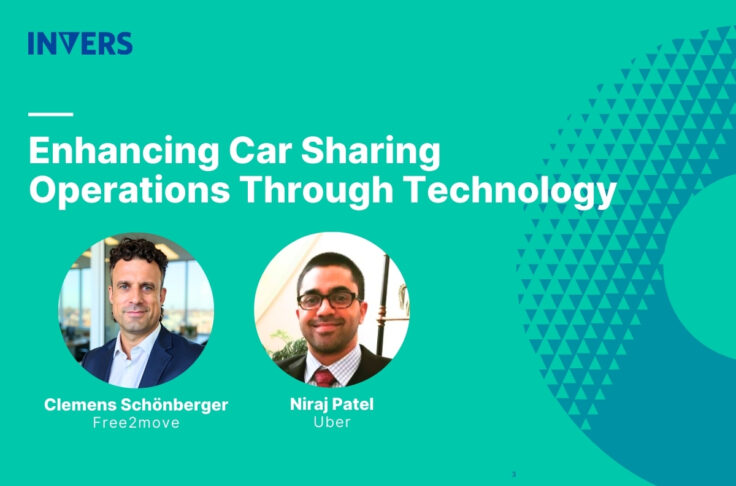Corporate Carsharing: Corporations Can Share Vehicles Too
Summary
Corporations need to be aware of the changing mobility landscape. Fleets need to realize they can make a large impact on the environment and people they serve by making changes that will reduce the fleet’s carbon footprint, whether that be through electrification or right-sizing.
This article was originally published in the October 2017 edition of Routes et Transports Magazine by Association québécoise des transports

When we think about traditional mobility or transportation options, most people imagine a personal vehicle, and possibly multiple vehicles in each household. On the corporate side, it wouldn’t be uncommon to imagine transportation allowances or a company car for some staff members.
The way people get around, which is referred to more often as “mobility” rather than “transportation” nowadays, has evolved over the years, with technology being an influential factor. Technology has brought innovative ideas to life, giving people a growing number of mobility options. For example, the growth of carsharing would not be possible without well-developed in-car technology. Similarly, ridesharing would not be possible without the increased availability of internet and smartphones.
This technology and mobility evolution created a new industry: shared mobility. Shared mobility “enables users to obtain short-term access to transportation as needed, rather than requiring ownership”1. This definition reflects the way people’s mobility behaviour has changed as well; as people become more aware of the true costs of private vehicle ownership, they begin to opt for more flexible, pay-as-you-use options.
Benefits of Shared Mobility
Transitioning away from private vehicle use to options in the shared mobility industry provides individual economic benefits as well as environmental benefits. These two factors also contribute to city-wide benefits that municipal planners need to begin taking advantage of.
On the individual side, the cost of vehicle ownership includes the variable cost of gas and maintenance, and the often overlooked insurance costs. With vehicles sitting idle for most of the day, the total cost of vehicle use does not seem like an efficient use of assets or money. By opting for shared mobility options, individuals can forego the high sunk cost of ownership and pay for only the time used with either a carshare, rideshare, or bikeshare. Seeing the true cost of mobility can also encourage people to walk or take public transportation more often as well.
On the environmental side, studies have shown that for every shared vehicle, 7-13 personal vehicles are removed from the road2. These are great statistics as congestion becomes a growing issue and city planners are struggling to find a solution. Carsharing membership in Canada has increased by almost 250% in the last 5 years alone; however, even with the growth of carsharing adoption, only a small fraction of trips made are done with a shared vehicle2.
For city planners, shared mobility is an opportunity to mitigate issues such as congestion, land use, and lack of public transportation. Cities need to adapt through policies and regulations and learn how to leverage the benefits of shared mobility. Cities will also need to take into consideration the impacts on congestion, parking spaces and use of roads to “make sure cost of mobility is equitable”3. In short, shared mobility has the potential to complement existing transportation options and reduce the number of cars on the road.
Commercial vehicles in Shared Mobility
In general, most of the conversations we hear about shared mobility focus on personal vehicle ownership versus shared vehicle use. However, corporate fleets have the opportunity to make a large impact on the way people move around as well. In the United States alone, there are 12.6 million commercial vehicles on the road4. These commercial vehicles represent around 5% of the overall number of vehicles on the road5. Though a small percentage, changing vehicle use for one fleet will impact the use of a few hundred vehicles right away.
Organizations can and should be part of the shared mobility ecosystem. Instead of assigning vehicles to individuals or departments, vehicles can be placed in a shared motor pool that is accessible across the whole company. While only a portion of fleets tend to belong to a shared motor pool, the opportunity to reduce vehicle maintenance costs while increasing the utilization of each vehicle is an appealing option to fleet managers and finance managers.
Benefits of Corporate Carsharing
More specifically, motor pools, otherwise known as corporate carsharing, provide a range of benefits to the organization from both a cost and environmental perspective. On the cost side, creating a motor pool results in consolidating vehicle resources and sharing them amongst a group of users. Given that vehicles are not typically used 24/7, the idea is for users to share vehicles, increase the utilization of those vehicles, thereby allowing a reduction in the number of vehicles in the fleet. Less vehicles result in lower maintenance and upkeep costs.
In addition, organizations form motor pools in order to:
- Reduce the number of underutilized vehicles in the fleet
- Streamline company vehicle usage
- Rightsize fleet
- Create an automated key dispatch process
- Manage trip data
In today’s environmentally-conscious world, governments are creating policies to quicken the adoption of fuel-efficient and electric vehicles. In an effort to meet clean energy guidelines, organizations are often mandated to reduce total carbon emissions from the fleet or opt for electric or hybrid vehicles. Creating a motor pool is a step towards environmental sustainability because it has the potential to reduce the number of vehicles in the fleet and accustom people to using electric vehicles.
Imlementing Corporate Carsharing
Any organization with a fleet can join the sharing economy by creating a motor pool or corporate carsharing service. In order to do so, there are a few aspects that need to be identified:
- How many vehicles are currently in the fleet and what are they used for
- How often are users using the vehicle
- What is your ideal operating budget
- What is the ultimate goal you want to achieve
Once you have identified these key aspects to your shared vehicle operations, we recommend shopping around for a vendor that meets your needs and you can see yourself building a long-term relationship with. Product capabilities may be similar between vendors, but relationship dynamics are likely to be different, and is important to focus on as you continue to improve your motor pool.
During the process of creating a motor pool, you must keep in mind one important set of individuals who will ultimately determine if the new process is a success or not – the drivers.
Choosing the right Tech Stack for Corporate Carsharing
When it comes to implementing new technology, it is easier to highlight return on investment by illustrating cost savings to management than to convince end-users that learning a new process will be beneficial to them. Humans are creatures of habit, and when you get someone to change a process they have been accustomed to, you are likely to receive some push back. Comments along the lines of “Things were working fine before” or “Why do we have to learn this new process” typically come up.
To overcome this barrier, organizations need to gain end-user buy-in. The driver, who is the end-user in this case, needs to be convinced of the benefits of a new motor pool system in order to build long-term success. By having the right communication strategies in place, your organization will be one step closer in achieving motor pool efficiency.
Strategy #1: Share the knowledge
Share regular updates with staff members so they are aware changes will be coming. You want to avoid the situation where unexpected changes are implemented, and staff are resistant because their learning curve for the role is now steeper and shortened. Being transparent is the key to this strategy; let the team know about the changes, and give them an idea as to what is going to change. If someone voices a concern, address it. You want to give staff the opportunity to accept the fact changes are coming so when it does happen, they are prepared.
Strategy #2: Identify ambassadors
Collaboration amongst all levels of staff is important to bring understanding and acceptance to any new technology that is going to impact processes. This strategy involves working with select individuals who represent the needs of the team, and is also influential and can help build buy-in. The ambassador will participate in select meetings so he or she understands the decision-making process more deeply. This way, if staff are disgruntled about the impending changes, they will have someone relatable to share their concerns with. Ideally, the ambassador will be able to discuss the changes from management’s view and gain acceptance from the staff.
Strategy #3: Collaborate with drivers
The process of deciding what new technology to implement is usually done at the management level. However, it is likely the management’s team that will be the one actually using the new technology and have to adapt to the new process. As a result, it is important to encourage sharing from the bottom up so management has a better understanding to drivers’ needs and wants, and balance that with their own goals. This approach will also build goodwill amongst staff by showing management is really looking out for the staff’s best interests.
Strategy #4: Phase in changes
To increase the chances of a smooth transition to the new technology, it is recommended to implement changes progressively. It’s hard to change people’s habits, so a full implementation of any new process will likely result in some barrier to acceptance. To overcome this, identify stages on how to introduce the new process. This will give people time to adjust, adapt, and become accustomed to the new process.
Conclusion
These strategies can work together or separately depending on how your organization is run. However, the overall theme of these strategies is communication. Having a plan on how to communicate change will ease pushback from staff and create a healthy work environment. The last thing that is needed is collusion among staff to resist the improved, arguably better process in place.
In summary, organizations with a fleet have the opportunity to join the shared mobility ecosystem and create a positive change in the environment. Getting staff to see these benefits and change their habits may prove to be difficult, but with the right communication strategies in place, user acceptance is achievable.
To launch your own motor pool or corporate carsharing service, contact us to learn more about our solution.
Resources
- “Shared Mobility: Current Practices and Guiding Principles.” Office of Operations, US Department of Transportation – Federal Highway Administration, 1 Feb. 2017, ops.fhwa.dot.gov/publications/fhwahop16022/ch1.htm#s12.
- Cohen, Adam, and Susan Shaheen. “Carsharing Trends and Research Highlights.” carsharing.org/wp-content/uploads/2017/06/YES_AdamCohen_CSA-2017_Final.pdf.
- Boutton, Shannon, et al. “The Future(s) of Mobility: How Cities Can Benefit.” McKinsey & Company, Sustainability & Resource Productivity, June 2017, www.mckinsey.com/business-functions/sustainability-and-resource-productivity/our-insights/the-futures-of-mobility-how-cities-can-benefit.
- IHS Automotive. “U.S. Commercial Vehicle Market Expected to Grow Slightly in 2016, IHS Says.” News Releases, IHS Markit, 26 Jan. 2016, news.ihsmarkit.com/press-release/automotive/us-commercial-vehicle-market-expected-grow-slightly-2016-ihs-says.
- Statista. “Number of Vehicles Registered in the United States from 1990 to 2015 (in 1,000s).” The Statistics Portal, 2017, www.statista.com/statistics/183505/number-of-vehicles-in-the-united-states-since-1990/.


